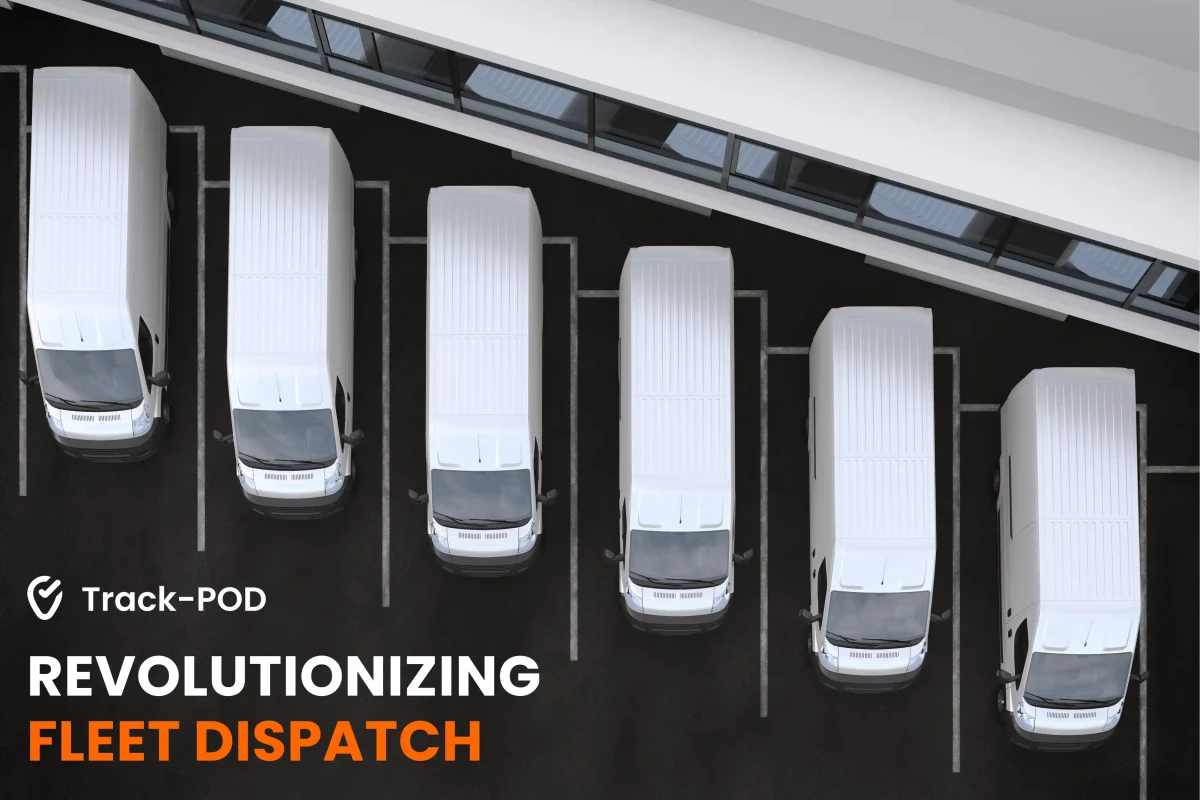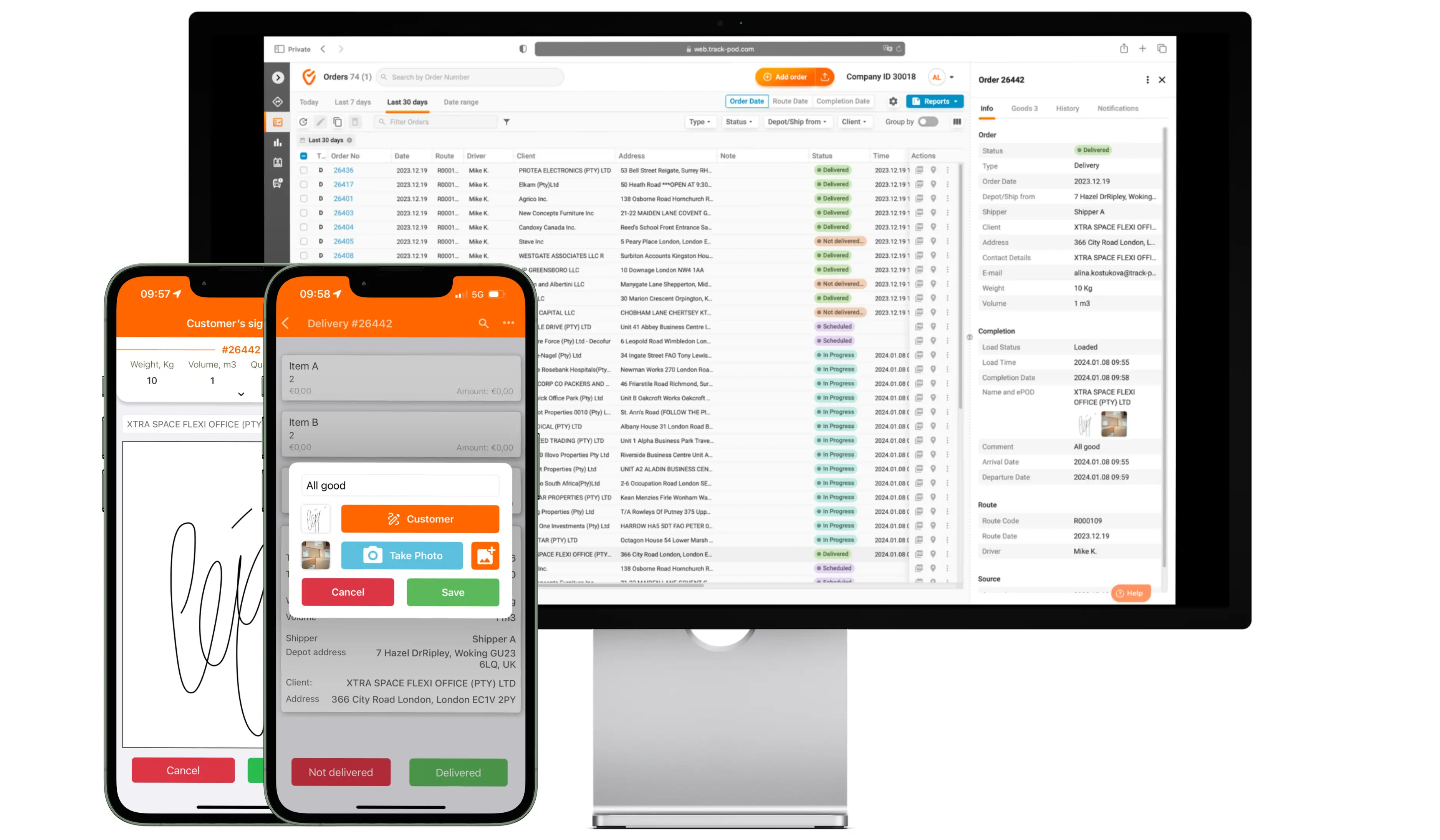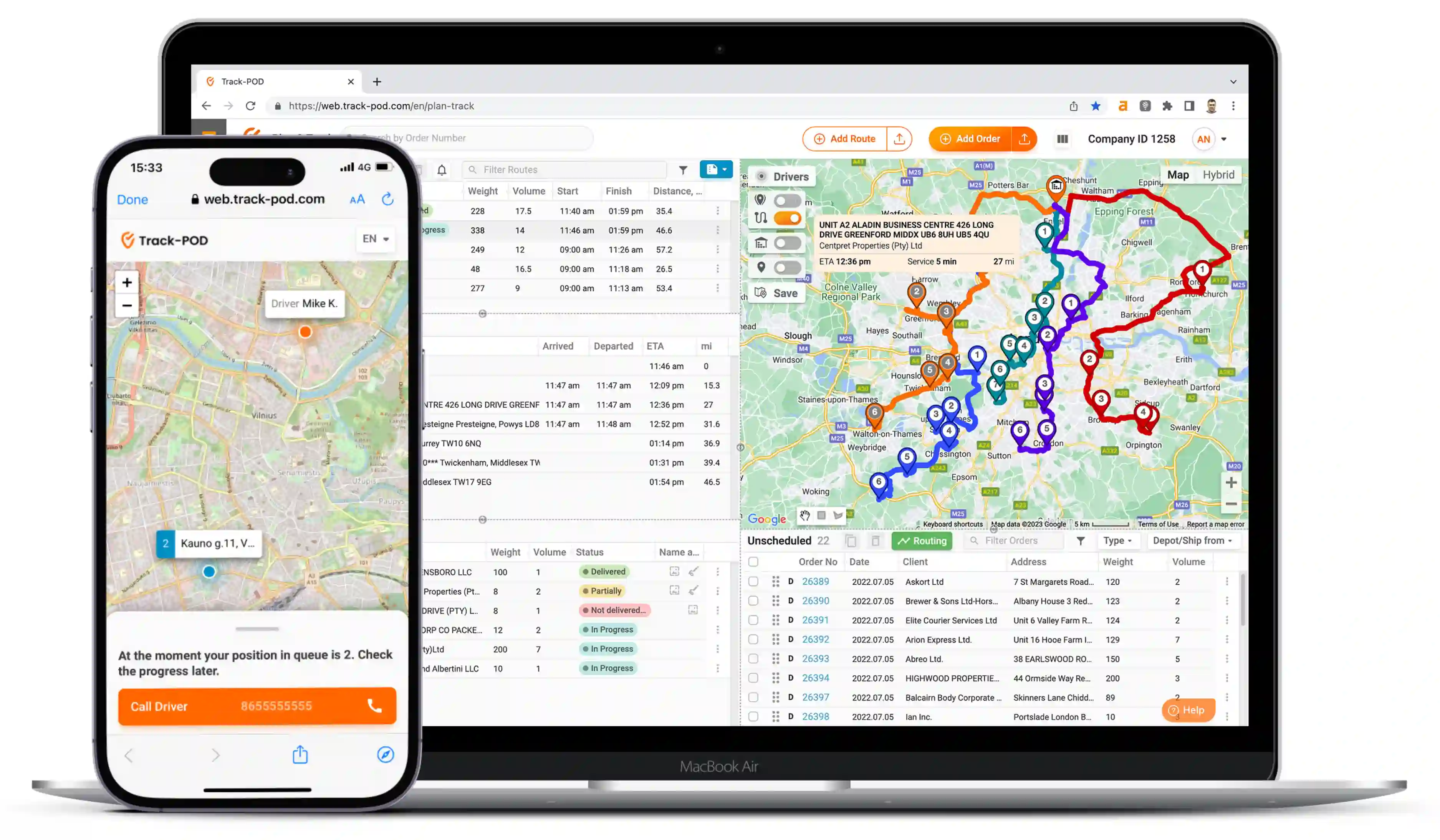Best Route Planning Software in 2025
This guide compares Track-POD, RouteManager, Circuit, and Upper, covering features, pricing, routing quality, and best-fit scenarios to help businesses choose the best route planning software for 2025.
Read More

For a long time, the transportation and logistics industry has used traditional methods to manage fleet dispatching. But these manual methods are becoming more difficult in today's complicated business world.
Fleet dispatchers have trouble with things like inefficient routes, not knowing where the vehicles are in real-time, too much paperwork and phone calls, and not being able to optimize well. This causes higher expenses, missed deadlines, not using assets efficiently, and unhappy customers.
Now, there's good news! Advanced dispatch management systems offer a great solution to improve fleet dispatch operations.
Precedence Research predicts that the Fleet Management market will grow to USD 57.82 billion by 2032.

Let's see how advanced dispatch management systems have changed fleet dispatch procedures, especially with the help of route planners.
In the past, dispatchers talked to drivers using radios or phones. Drivers had to cope with tough situations without getting any help right away.
Fleet dispatching primarily relied on manual processes and a paper-based logging system. It made the whole process tiring and difficult for the managers as well.
Manual dispatch management is inefficient. It has higher chances of missing packages, failed deliveries, routing inefficiencies, and much more.
You should be aware of the limitations and issues of the traditional dispatch methods as well, so let's discuss them now:
Now that you’re aware of how inefficient manual dispatching can be, you should also know that an advanced dispatch management system can handle all of it with 1-click integrations. We’ll be discussing more about it ahead, so keep reading.
An advanced fleet dispatch system is like a super-smart helper for people who have a bunch of vehicles and need a solution to automate the dispatch process.
Imagine you're in charge of making sure all your vehicles are going to the right places at the right times. It can be quite tricky keeping track of everything, right? That's where the advanced fleet dispatch system comes in.
“Automated solutions leverage advanced software and communication technologies to enhance efficiency and decision-making in various aspects of fleet operations.”
Courier software is one of the forms of automated dispatch systems. We at Track-POD have designed a Courier Dispatch Software keeping in mind businesses of all sizes.

Some of the key features of an automated fleet dispatch system include:
Implementing advanced dispatch management systems can bring about a range of positive effects for businesses operating fleets. Here are some key benefits:
Automation of the dispatch process streamlines operations, reducing manual effort and time required for tasks such as routing, scheduling, and communication. This leads to faster response times and increased overall efficiency.
The fleet managers can actively monitor the location of their fleet members from the app. This helps monitor driver behavior, ensures the deliveries are on schedule, and addresses any issues that come up immediately.
The advanced systems automatically optimize the routes and streamline operations, which ultimately leads to cost savings. If you want to minimize your fuel expenses, reduce overtime payments, and lower maintenance costs, you should opt for an advanced dispatch system.
When the clients know when their parcels will arrive, they are more likely to be satisfied with the service. And this software does exactly that. Advanced dispatch systems provide customers with information, including ETAs, leading to positive reviews.
These systems often include features to help businesses comply with regulatory requirements. This ensures that the fleet operates in accordance with industry standards, avoiding potential legal and financial consequences.
Advanced order dispatch systems are designed to handle the complexities of growing fleets. They provide scalability to accommodate an increasing number of vehicles, drivers, and operational demands without sacrificing efficiency.
If you've got a large fleet of vehicles that needs managing, you’ll need efficient routing software.
“Routing software tracks deliveries in real-time and keeps the customers in the loop. Essential for making successful deliveries.”
Planning delivery routes can be pretty overwhelming. You have to think about a bunch of things, like how heavy the packages are, the size of the delivery truck, and when and where to stop. But, with Track-POD's delivery route software, all those worries vanish.

Implementing advanced dispatch management systems with route planner software brings substantial benefits to fleet operations. These systems optimize routes, reducing fuel consumption. They also improve delivery times and positively impact driver productivity.
The dynamic adaptability of a route planner ensures efficient responses to changing conditions, contributing to the reliability of delivery schedules and customer satisfaction.
In essence, the integration of route planners in advanced dispatch management systems not only enhances operational efficiency and reduces costs but also improves customer satisfaction, supports sustainability goals, and positions businesses for scalable growth within the dynamic landscape of fleet management.
If you’re wondering if Track-POD is the right choice for you, we’ve got some case studies that would help you understand the benefits of our software.
Recently, two companies, Skuba Group, and ACDC Dynamics, secured our services, and they are now delivering 2x faster with no missing parcels. We have conducted a thorough study on both of them to help you understand more about our software features.
Skuba Group is a truck and trailers expert in Europe with over 180 branches and serving over 72,000 customers annually. The company needed help in calculating the precise ETA, keeping the customers informed about their deliveries and distributing the flow of shipments among their drivers.
Seeing these problems, we contacted their Logistics Manager and introduced our software to them. With the software, they had all the deliveries summed inside a page, and that too with the help of a map.
Drivers are now given coordinates instead of addresses as it becomes easier for the drivers to reach the exact dropoff location. Now, Skuba is making 2x faster deliveries with over 100+ drivers. The company has saved a lot of fuel and manual costs after integrating our routing software with their business.
ACDC Dynamics is a leading manufacturer, distributor, and importer of quality electrical products. The company was able to integrate our routing software with their business with ease.
Before our software, they were using manual procedures to dispatch over 600 to 800 orders a day. The main problem they were facing was that it was time-consuming and needed manpower to do the tasks.
Once they started using Track-POD, the process was streamlined. There were 0% failed deliveries, and 100% of drivers could be tracked anytime through the app.
Also, as the app is easy to use, the drivers got the hang of it in merely two days. And now, the chat room is the main communication hub. The company is also saving 4% fuel every month because of it.
As a Logistics Manager, implementing and utilizing advanced dispatch management systems can be tedious as it requires careful planning and strategic considerations. But to make it easier for you guys, we’ve summed up some practical tips and best practices. Let’s see what they are.
At first, you should thoroughly understand your fleet's operational needs. Identify pain points, challenges, and areas that need improvement to customize the dashboard as per your specific requirements.
Now that you know what you need for this to work, it’s time for you to choose a system that aligns with your business size, industry, and operational complexity. You should consider the following while doing so: Scalability, ease of use, and the system's compatibility with your existing technologies.
Using a new system can be difficult, so It is important to invest in comprehensive training for your dispatchers and drivers. It ensures that they understand the system's functionalities and how to use them effectively.
Once the software is integrated with your business, then develop clear and standardized protocols for using the dispatch system. Define roles, responsibilities, and communication procedures to ensure an efficient workflow.
When there a real-time data capabilities, so why not leverage it too? Monitor vehicle locations, status updates, and other relevant information to make timely and informed decisions.
It's on the manager to ensure seamless integration with other business systems, such as inventory management and customer relationship management.
Customer feedback is the most important aspect of any business. You, as a manager, should encourage dispatchers and drivers to share their experiences, challenges, and suggestions weekly or monthly to improve the system accordingly.
A plus would be to establish and monitor key performance indicators. These should be related to fleet efficiency, fuel consumption, delivery times, and customer satisfaction. Then, use these metrics to assess the system's impact and identify areas for continuous improvement.
Offer continuous support to users. Having a dedicated support team that can address issues promptly and provide assistance when needed can boost the efficiency of any business. It’d be better if your business had one.
Make sure you implement these strategies to use the automated fleet dispatch system efficiently. You can also contact our customer support representatives if you get stuck anywhere.
Now that you’re familiar with advanced dispatch systems, case studies, and best practices, let’s take a look at the emerging technologies and upcoming trends in fleet dispatch management. These trends offer innovative solutions to enhance efficiency, safety, and overall operations.
Governments worldwide are pushing towards zero-emission vehicles by 2030. It’s the reason why the adoption of electric and autonomous vehicles is on the rise. These cars have advanced sensors that collect real-time data for planned deliveries, thus reducing labor costs.
Autonomous vehicles will be a game-changer in the fleet management industry. They offer benefits such as reduced downtime, improved safety, and cost-cutting.
The automotive telematics market is projected to reach USD 15.5 billion by 2027. Dispatchers can leverage telematics for active monitoring of vehicles and driver updates and behavior, tracking vehicle performance, and analyzing traffic patterns.

Telematics is included in every aspect of fleet management nowadays. It provides live updates that ensure safer fleets, reduce fuel costs, enable predictive maintenance, and offer cost-effective insurance.
Telematics and the IoT are used closely in fleet management systems. With the recent advancements in sensor technology integrated with IoT, fleet operations have transformed dramatically. Smart devices and sensors play a vital role in minimizing package damage during distribution, actively collecting data for proactive decision-making.
The MaaS market is expected to reach USD 951.23 billion by 2030. That’s why, fleet managers are customizing services and shifting from traditional approaches. They are off to exploring vehicle sharing and leasing options to minimize transportation costs and maximize efficiency.
Blockchain technology enhances transparency and accountability in fleet management. With Web 3.0 technology on the rise, blockchain could be one of the key components in fleet management. It facilitates easy, automated payments through smart contracts, ensuring secure and transparent transactions.
The decentralized ledger system of blockchain also provides unalterable record-keeping. It improves traceability for vehicle maintenance, driver history, delivery routes, and cargo records.
The world as we know it is now moving towards 5G connectivity. It accounts for faster and more reliable data transfer. Fleet managers can now leverage the use of 5G technology in their systems to track vehicles in real-time and optimize fleet operations as needed.
So that’s all for the evolution of fleet dispatching from manual processes to advanced dispatch management systems. With features such as real-time tracking, automated routing, and enhanced communication, advanced dispatch management systems streamline operations, reduce costs, and significantly improve overall efficiency.
If you’re a new or established business, you should have a dispatch management system to handle all your deliveries. So, if you want better efficiency, faster delivery times, and real-time tracking, consider using automated transportation dispatch systems.
Also keep in mind that everything you have just read about the software, you can try it out for free as well. Start today with a 7-day free trial of Track-POD.